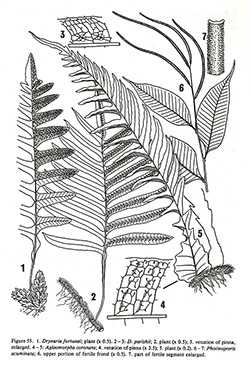e-Flora of Thailand
Volume 3 > Part 4 > Year 1989 > Page 548 > Polypodiaceae > Drynaria
6. Drynaria parishii (Bedd.) Bedd.wfo-0001230328
Suppl, Ferns S. India.: 24. 1876; Tardieu & C.Chr. in Fl. Indo-Chine 7(2): 520. 1941; Tagawa. J. Jap. Bot. 38: 329. 1963; Tagawa & K.Iwats., Acta Phytotax. Geobot. 24: 175. 1970.— Pleopeltis parishii Bedd., Ferns Brit. India t. 125. 1866. Fig. 55. 2–3.
Accepted Name : This is currently accepted.
Description : Rhizome long-creeping, up to 1 cm diam., densely scaly throughout; scales persistent, narrowing from peltate base to attenuate apex, pale brown with still paler margin and dark central point, about 6 by 1.5 mm, marginate with long downy white hairs. Nest-leaves wanting. Foliage-leaves: stipes stramineous, 5–10 cm long on scaly phyllopodes, scaly at base with those like rhizome-scales, very narrowly winged almost to the base; laminae oblong, up to 25 by 20 cm, deeply lobed almost to rachis remaining very narrow wings of rachis less than 2 mm in breadth; lobes 5–9(–11) pairs, oblanceolate, broadest usually at ⅓ part from apex, slightly narrowing to base, moderately acute to acuminate at apex, subentire and more or less crisped at margin, up to 11 by about 2 cm, patent or slightly ascending; veins raised on lower surface, anastomosing, 3–5 rows of areoles between adjacent main veins, with included free veinlets; chartaceous, green to paler. Sori round, in one row on each side of costa, rather close to costa, one between main veins, raised on upper surface.
Thailand : NORTHERN: Chiang Mai (Huai Tong, Doi Chiang Dao, Doi Suthep, Tin Tok, Bo Luang), Lamphun (Doi Khun Tan), Tak (Rahaeng, Khao Pha Wo, Doi Musoe); SOUTH-WESTERN: Kanchanaburi (Si Sawat, Khao Ri Yai).
Distribution : Burma (Moulmein – type), Vietnam.
Ecology : On mossy tree-trunks in dense evergreen forests usually on ridges at 600–1,300 m alt.
Notes: On the herbarium sheet of Smith's collection in US, Christensen (1941) suggested that those might be Drynaria delavayi, from which Thai plants are different in rhizome-scales, venation, number and form of lateral lobes. In Thailand, there is no evidence of D. delavayi which is common in SW China.
E-version notes : For more details see Ferns of Thailand, Laos and Cambodia.

